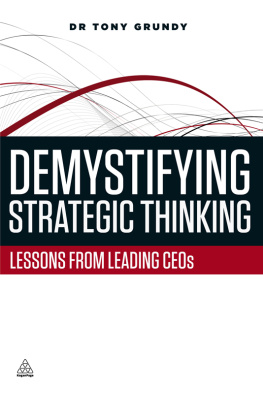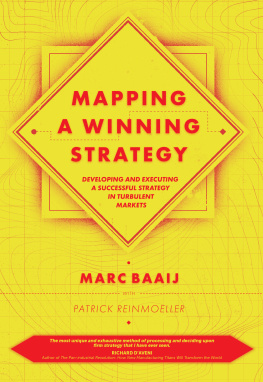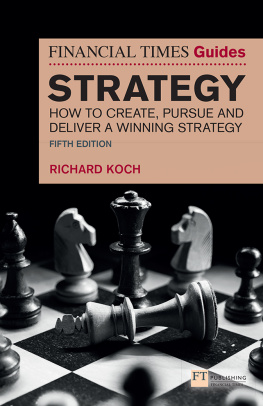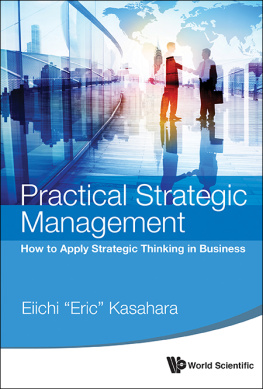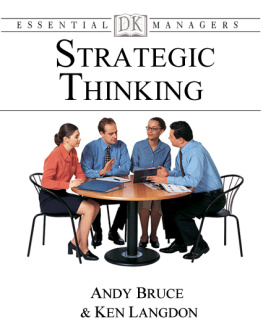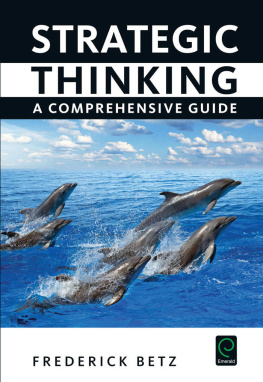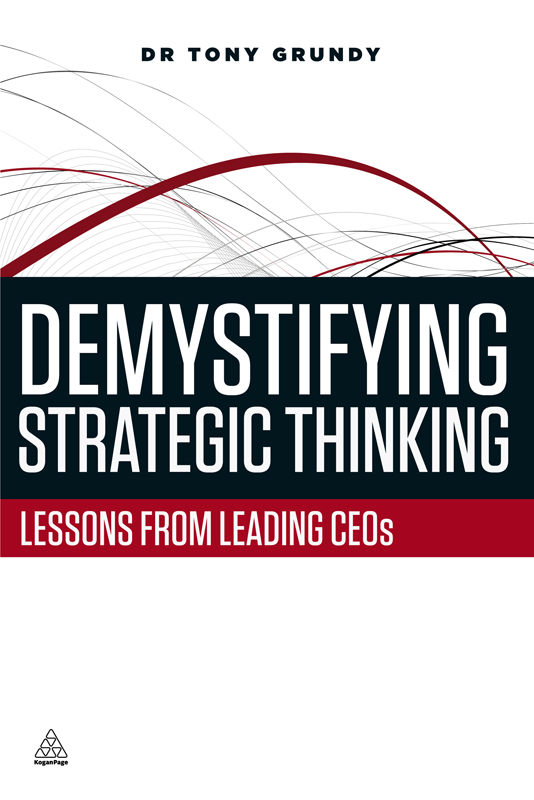Note on the Ebook Edition For an optimal reading experience, please view largetables and figures in landscape mode. |
This ebook published in 2014 by
Kogan Page Limited
2nd Floor, 45 Gee Street
London EC1V 3RS
United Kingdom
www.koganpage.com
Tony Grundy, 2014
E-ISBN 9780749469450
Contents
I would like to thank my wife, Dr Carolina Yepes, for shining her light and her love into my life, and for making this and my previous book such light work in the most challenging period of my life. I am indebted to her psychological influence in this book.
I also send all my love and my thoughts to Thomas, who is never far from my mind, and I hope that one day you will be able and wish to be a dearest companion in lifes journey once again. May you enjoy Alice in Wonderland and never forget its inner lessons.
Why is the future important? Because we will spend the rest of our lives in it.
(ANON)
Strategic thinking is often talked about as a sexy management process, but it is not so often defined and even less frequently explored. Similar in many ways to ideas such as innovative thinking, leadership, or transformational change, it is more often than not unclear and ambiguous what it is actually about. Even more of a mystery is what it entails and when one should do it, and on what topics.
Googling strategic thinking brings up a lot of more general material on strategic management, but this tends to be thick with concepts and theory, but thin on cognitive processes. Essentially, therefore, to understand strategic thinking one needs to have some understanding of the practical aspects of psychology.
This is my 19th text on management (20 th , counting my sole one on something rather different). These writings have evolved over 20 years and are a reflection on theory, research, experiences and insights and are very much concerned with practicality. This book is essentially about three things: strategic thinking, demystifying its nature, and practicality, and is a follow-on from my previous one, Demystifying Strategy (Grundy, 2012) which combined different perspectives on strategy with a very particular framework of thinking processes and tools, case studies and many practical do-it-yourself exercises. Demystifying Strategy set out to shed a practical I can do it myself perspective on what in many texts is a somewhat exotic and esoteric subject. The result of the more abstract treatment is that strategy is positioned in managers minds as being remote from everyday experience. In that earlier volume, the focus on demystifying was explicit and ruthless (even at the risk of upsetting colleagues at business schools). Its philosophy was that in the modern management world no one really has time for over-elaborate and mystical strategic concepts and ideas.
Most really good strategic ideas are actually quite simple, not elaborate, and so too it was with this book. I was on the beach at a five-star luxury hotel in Cancun, Mexico, the Grand Paraiso on honeymoon (strategic heaven) when the idea came to me. That thought was a true product of strategic thinking in that it combined ideas from disparate sources My previous book was an account of how strategy, as a more general concept, could be demystified, addressed from my perspective and from my experience. But my thought on that beautiful Mexican beach was: Why not explore how senior managers and directors actually process it cognitively? Indeed, even further, why not go out and ask some real CEOs how they see it, how do they do it, what is its value, and what are the challenges and constraints?
I knew that when one explores a topic such as this at director level or above, it will generate a wealth of most interesting reflection and many insights. While thinking about it on the beach I then had the further idea of making the core material of this book not just straightforward answers to a series of open questions, but to actively engage with each CEO in a dialogue, and record and analyse that.
As I was not encumbered with the need to make this squeaky-clean methodologically this would not only produce rich insights but also ones of a unique nature. Unconstrained by some need to publish to the great and the good of the academic world to score some research qualification, I could probe existing thinking and stimulate some new thinking too. So I set out with the idea that the material would be much more a kind of Aristotelian dialogue. In that process I would also be taking the stance that while I was going to be alert to new themes and issues that CEOs raised, either explicitly or implicitly, I would also draw in my tacit knowledge. This has been gained not only through rigorous academic research but also in over 25 years of independent strategy consulting experience as a facilitator, and similarly as an executive developer and strategy coach.
Having already written Demystifying Strategy would also give me a tight framework to which I could relate these dialogues. Also, people could read this book first and if they decided that they need to get more familiar with strategic frameworks, they could go back and read the earlier one or readers of Demystifying Strategy could pick up where I left off and explore the practical world of how CEOs see it and do it.
Fifty shades of strategy
In truth I was also inspired by two other things. First, one of my case studies that I have used in the past is Disneys acquisition of Marvel. The take from that was that Marvel Studios would do a whole series on the same thing: the fabulous four, one, two, three The demystifying theme was too powerful to be left to just one book. Also were there to be more than one book both being complementary then that would help the sales of both. The second strand was that I had been reading the first of the trilogy Fifty Shades of Grey , a somewhat risqu set of novels that has become, it is claimed, the bestseller of all time. This proved that it was possible to develop a book theme in more than one volume (obviously there have been a number of earlier series that have accomplished the same thing).
This book, like my last one, is built around the notion that strategies and strategic thinking should be a little special: and that means searching for some kind of cunning plan. And reading that Fifty Shades book was a most cunning plan to find out what its appeal had been (yes, I know, you dont believe me). I wanted to understand what was behind its phenomenal success: its gestation and thus market testing through fan fiction. Due to the spread of the Kindle, etc people could read it without anyone else seeing the cover. One of the lessons here on strategic thinking is that ideas often come from the most unlikely sources.
While Demystifying Strategic Thinking: Lessons from leading CEOs doesnt purport to be a comprehensive account of the whole topic of leadership, it does still give us many insights into the adjacent topic of strategic leadership as experienced at CEO level. That is a secondary goal.
This Introduction is quite long as it not only tells us what to expect in the book but also links to Demystifying Strategy and has a number of practical illustrations of real strategic thinking. The latter are light and stimulating to read so I hope you will enjoy them.
This book is intended for a number of key target audiences:
- Senior managers who wish to learn how to do strategic thinking and in particular to learn how CEOs do it and to understand the problems and issues they have in doing it, either because they would like to be CEO one day, or simply to model those cognitive behaviours.

